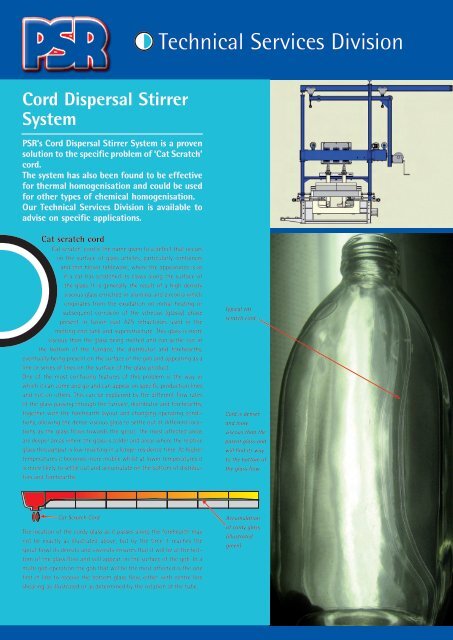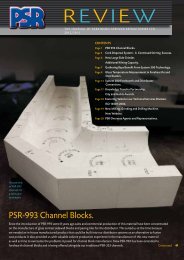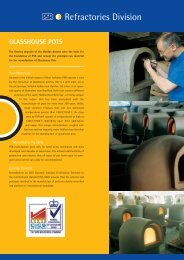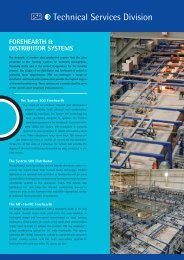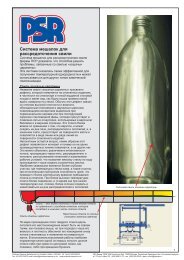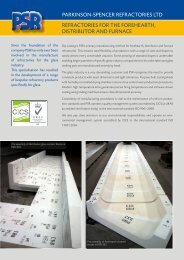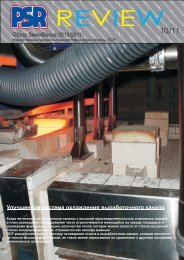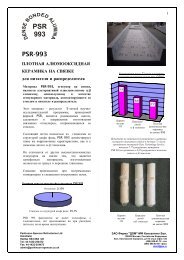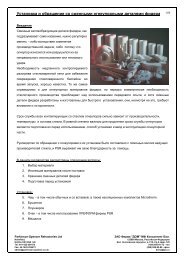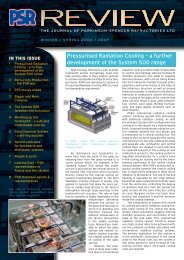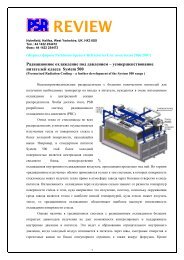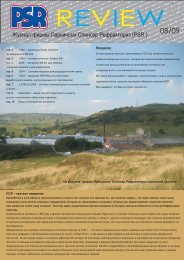PSR Cord Dispersal - Parkinson-Spencer Refractories
PSR Cord Dispersal - Parkinson-Spencer Refractories
PSR Cord Dispersal - Parkinson-Spencer Refractories
Create successful ePaper yourself
Turn your PDF publications into a flip-book with our unique Google optimized e-Paper software.
Technical Services Division<br />
<strong>Cord</strong> <strong>Dispersal</strong> Stirrer<br />
System<br />
<strong>PSR</strong>’s <strong>Cord</strong> <strong>Dispersal</strong> Stirrer System is a proven<br />
solution to the specific problem of ‘Cat Scratch’<br />
cord.<br />
The system has also been found to be effective<br />
for thermal homogenisation and could be used<br />
for other types of chemical homogenisation.<br />
Our Technical Services Division is available to<br />
advise on specific applications.<br />
Cat scratch cord<br />
'Cat scratch' cord is the name given to a defect that occurs<br />
on the surface of glass articles, particularly containers<br />
and thin blown tableware, where the appearance is as<br />
if a cat has scratched its claws along the surface of<br />
the glass. It is generally the result of a high density<br />
viscous glass enriched in alumina and zirconia which<br />
originates from the exudation on initial heating or<br />
subsequent corrosion of the vitreous (glassy) phase<br />
present in fusion cast AZS refractories used in the<br />
melting end tank and superstructure. This glass is more<br />
viscous than the glass being melted and can settle out in<br />
the bottom of the furnace, the distributor and forehearths,<br />
eventually being present on the surface of the gob and appearing as a<br />
line or series of lines on the surface of the glass product.<br />
One of the most confusing features of this problem is the way in<br />
which it can come and go and can appear on specific production lines<br />
and not on others. This can be explained by the different flow rates<br />
of the glass passing through the furnace, distributor and forehearths,<br />
together with the forehearth layout and changing operating conditions,<br />
allowing the dense viscous glass to settle out at different locations<br />
as the glass flows towards the spout. The most affected areas<br />
are deeper areas where the glass is colder and areas where the relative<br />
glass throughput is low resulting in a longer residence time. At higher<br />
temperatures it becomes more mobile whilst at lower temperatures it<br />
is more likely to settle out and accumulate on the bottom of distributors<br />
and forehearths.<br />
Typical cat<br />
scratch cord<br />
<strong>Cord</strong> is denser<br />
and more<br />
viscous than the<br />
parent glass and<br />
will find its way<br />
to the bottom of<br />
the glass flow<br />
Cat Scratch <strong>Cord</strong><br />
The location of the cordy glass as it passes along the forehearth may<br />
not be exactly as illustrated above, but by the time it reaches the<br />
spout bowl its density and viscosity ensures that it will be at the bottom<br />
of the glass flow and will appear on the surface of the gob. In a<br />
multi gob operation the gob that will be the most affected is the one<br />
first in line to receive the bottom glass flow, either with centre line<br />
shearing as illustrated or as determined by the rotation of the tube.<br />
Accumulation<br />
of cordy glass<br />
(illustrated<br />
green)
The stirrer system<br />
The purpose of the <strong>PSR</strong> <strong>Cord</strong> <strong>Dispersal</strong> Stirrer System is to lift the dense, viscous cordy glass off<br />
the bottom of the forehearth and to mix it into the body of the glass so that it is no longer present<br />
on the surface of the gob during the forming operation and then no longer readily visible in the<br />
final article. In order to achieve this we use twin counter-rotating paddle type stirrers that have<br />
a wide sweeping area and are effective at stirring and lifting material that is located at or near<br />
the bottom of the glass flow.<br />
The stirrers are located in the equalising section close to the spout, their exact location and<br />
configuration depending upon channel width, depth and profile.<br />
Although the 'cord' forming material is still present in the glass, after stirring it is no longer<br />
concentrated on the gob surface and is distributed throughout the base and sidewalls of the<br />
article during the forming process so that it is no longer readily visible in the finished product.<br />
Features of the <strong>PSR</strong> <strong>Cord</strong> <strong>Dispersal</strong> Stirrer System<br />
• Can be fitted to any design of forehearth.<br />
• Suitable for forehearth widths of 26” (660mm) and above. For forehearth widths less than 26”<br />
(660mm) twin counter-rotating helical type stirrers are specified.<br />
• Different stirrer configurations are available to suit specific cord problems and installations.<br />
• Can be installed with pre-existing drains. In some instances the drains have then been stopped.<br />
• Can be installed with pre-existing submersed electric boost electrodes.<br />
• With a suitable pre-configured access slot the system can be installed on-the-run. If an access<br />
slot is not available equalising section superstructure refractories can be replaced to provide one<br />
during job change or other machine stoppage with typically a maximum of 6 hours production<br />
interruption.<br />
• Cat scratch cord appearance closely and predictably controlled by adjusting stirrer speed.<br />
Stirrer speed can be reduced to minimum as cord condition improves.<br />
• Stirrer life typically 6-12 months (based on <strong>PSR</strong> stirrers and subject to service conditions).<br />
• Stirrer configuration provides high stirring efficiency at low stirrer speeds (typically 2 to 5<br />
revolutions per minute) to minimise stirrer wear. Stirring efficiency can be maintained as stirrers<br />
wear by increasing stirrer speed.<br />
• Stirrer operation does not interfere with thermocouple readings or gob weight control.<br />
Fluctuations in downstream infra-red thermometer readings due to disturbance of the glass<br />
surface can be overcome by filtering of the temperature signal.<br />
• Stirrer operation can assist thermal homogeneity at spout entrance.<br />
• Stirrer operation does not contribute to glass head loss and can reduce glass head loss at high<br />
forehearth loads.<br />
• Increased channel block corrosion at the stirrer position is minimal. Any local additional<br />
long term wear can be accommodated by stirrer operating height adjustment. This can in fact<br />
be beneficial to the stirring operation as the stirrers then operate at a height lower than the<br />
adjacent upstream channel block base to better lift the cordy material.<br />
• Stirrer mechanism mounted to casing top flange provides ease of installation. Can be mounted<br />
to support steelwork or forehearth platform if casing support is inadequate.<br />
• System design allows stirrer mechanism to be raised up, pulled out to the side and then<br />
lowered to forehearth platform level for easy stirrer replacement and mechanism maintenance.<br />
• Stirrer variable speed drive motor and gear box mounted on the stirrer cross beam for easy<br />
access. Cable management system allows stirrers to be operated outboard at the side of the<br />
forehearth, above the forehearth or with the stirrers above glass level to ensure correct stirrer<br />
operation before final positioning.<br />
• Stirrer system control panel houses the inverter drive which controls the stirrer drive motor<br />
speed and provides indication and control of the stirrer rotational speed as well as local and<br />
remote alarming of stirrer faults.<br />
• Access to speed control and inverter drive locked to prevent changes by unauthorised personnel.<br />
• 5 year inverter drive warranty.<br />
• Control panel can be mounted in control room or supplied with air-conditioning unit for<br />
mounting on machine shop floor.<br />
• Air-cooled carbon bearings and stainless steel stirrer chucks ensure accurate and concentric<br />
stirrer rotation, reliability of operation and minimal maintenance.<br />
• Adjustable shaft mounted bevel gears enable reliable setting of relative stirrer positions during<br />
installation.<br />
• Designed, manufactured and supplied by <strong>PSR</strong>. System performance guaranteed.<br />
• <strong>PSR</strong> engineer ensures correct on-site installation. Original <strong>PSR</strong> spares and refractory parts<br />
ensure long term satisfaction.<br />
A <strong>PSR</strong> <strong>Cord</strong> <strong>Dispersal</strong> Stirrer System in service<br />
Stirrer Control Panel<br />
The occurrence of ‘cat scratch’ cord is now becoming<br />
so prevalent that the equalising section of every new<br />
forehearth from <strong>PSR</strong> is pre-configured for the subsequent<br />
installation of stirrers. This includes the provision of cutouts<br />
in the roof blocks with cover tiles to close the position,<br />
together with pre-configuration of the superstructure<br />
steelwork to enable a stirrer support frame to be retrofitted<br />
quickly and easily if required.<br />
Typical equalising section superstructure pre-configured<br />
for a <strong>Cord</strong> <strong>Dispersal</strong> Stirrer System<br />
Summary of benefits of the <strong>PSR</strong><br />
<strong>Cord</strong> <strong>Dispersal</strong> Stirrer System<br />
• Guaranteed to eliminate or reduce any typical cat scratch<br />
cord defect to acceptable levels (subject to prior technical<br />
evaluation).<br />
• Can be installed on-the-run.<br />
• Does not require special ‘drain channel block’. Where ‘drain<br />
channel block’ is installed continuous operation of the drain is<br />
required to prevent build-up of cordy glass and “cat scratch”<br />
problem.<br />
• Stirrers can be reduced to minimum speed, stopped and raised<br />
above the glass or removed completely when no cord is present.<br />
• No reduction in production output associated with a drain.<br />
• No cost of waste glass associated with a drain.<br />
<strong>Parkinson</strong>-<strong>Spencer</strong> <strong>Refractories</strong> Limited, Holmfield, Halifax, West Yorkshire, UK. HX3 6SX<br />
Tel: (44) (0) 1422 254472 • Fax: (44) (0) 1422 254473 • Email: admin@parkinson-spencer.co.uk • www.parkinson-spencer.co.uk


